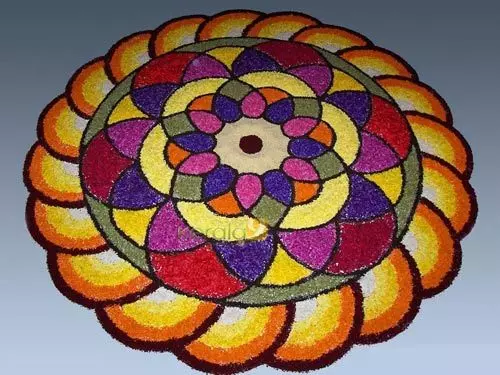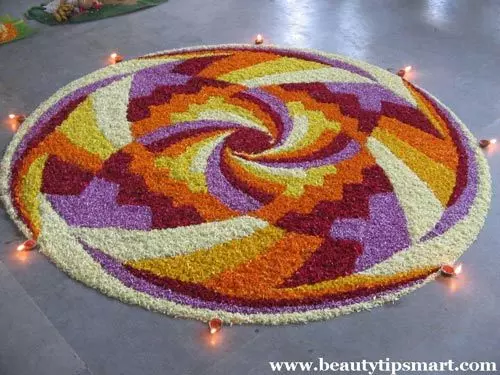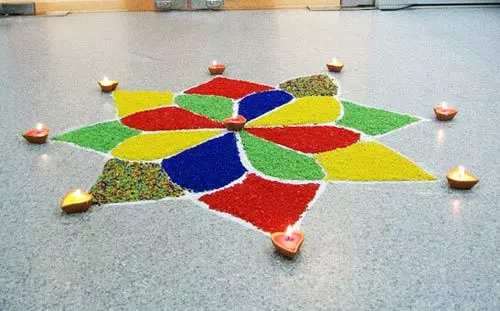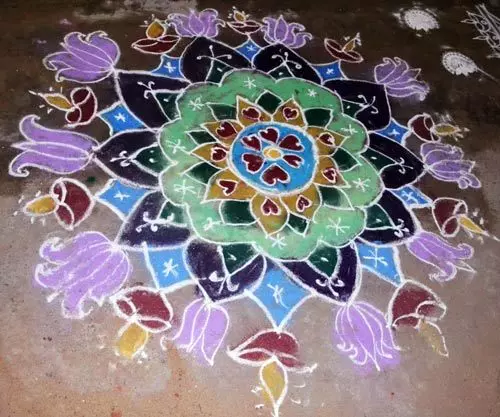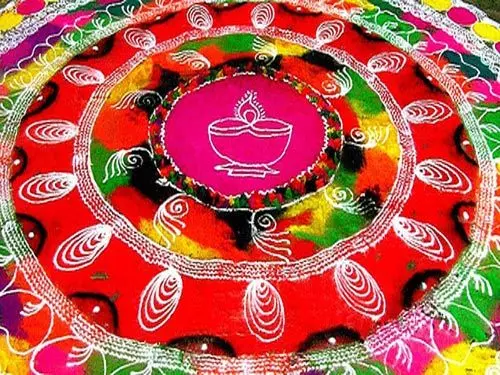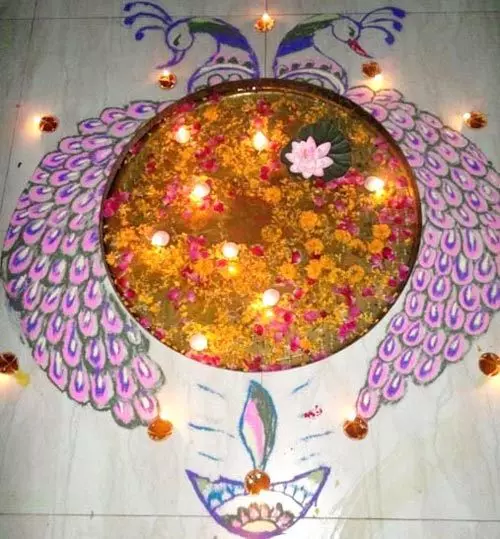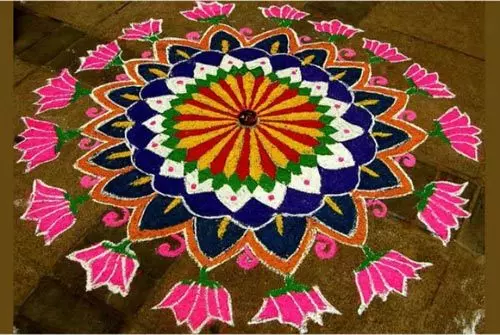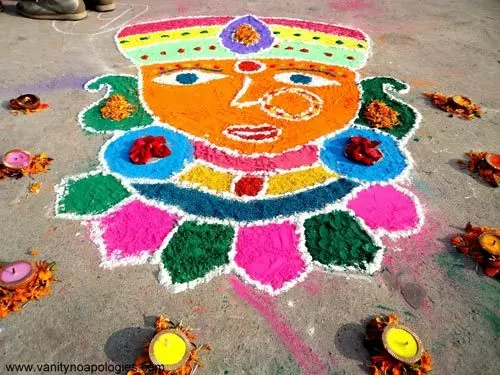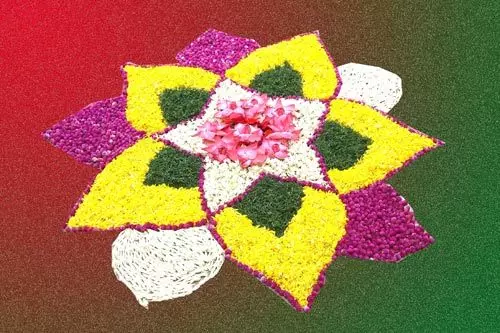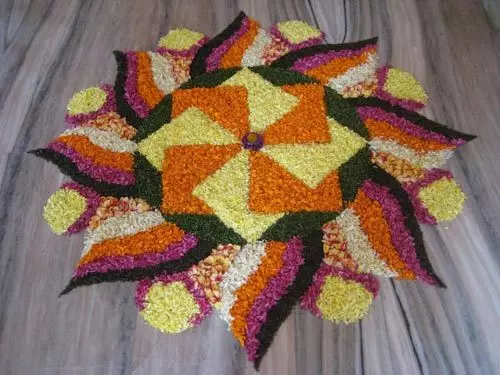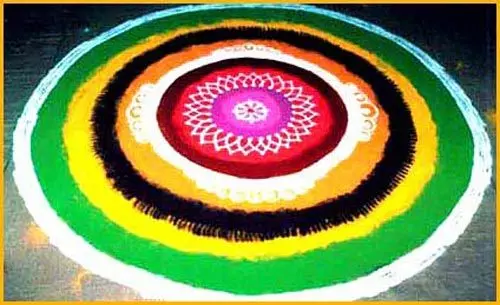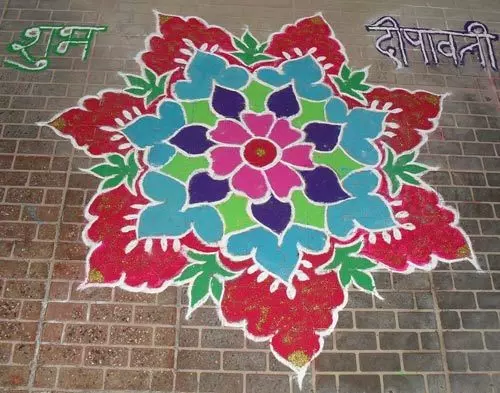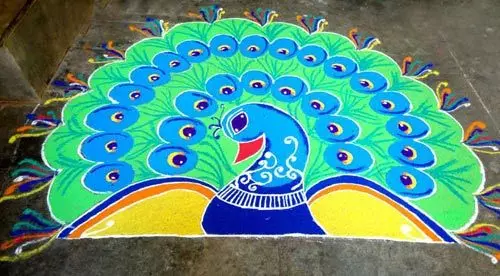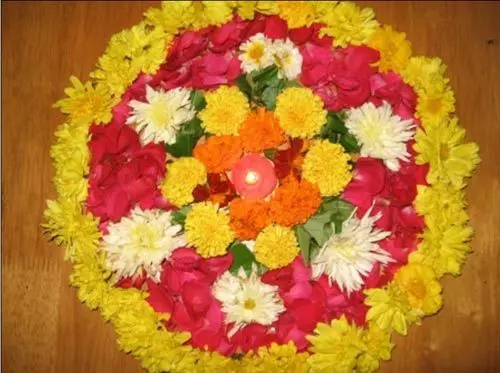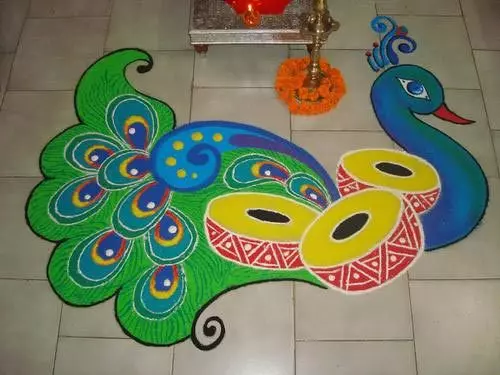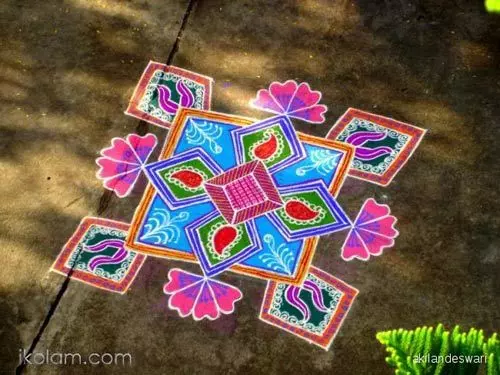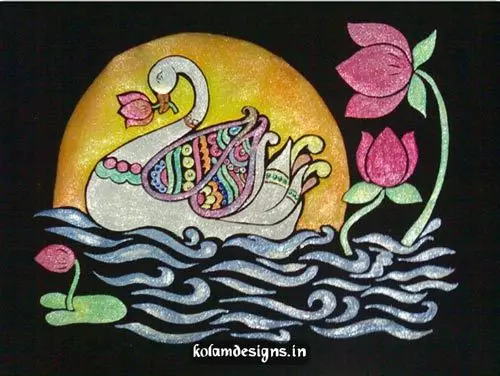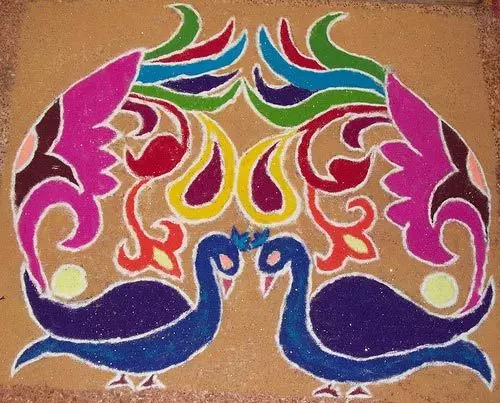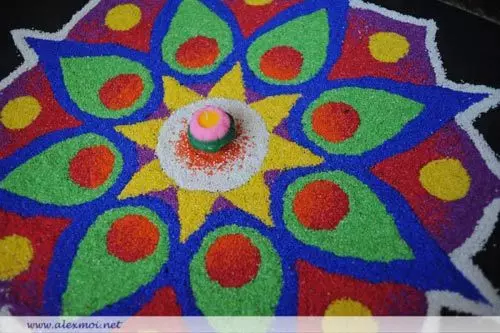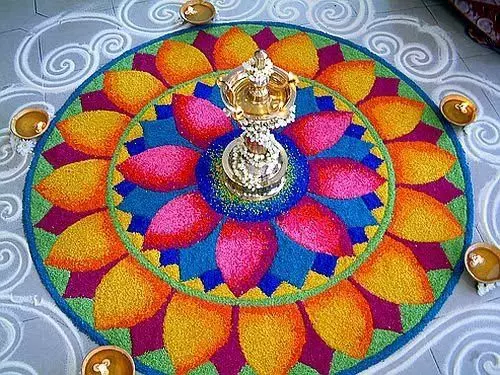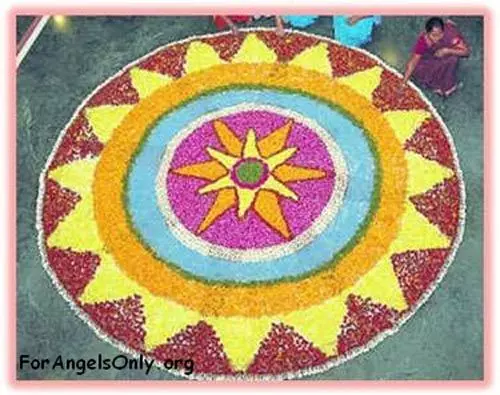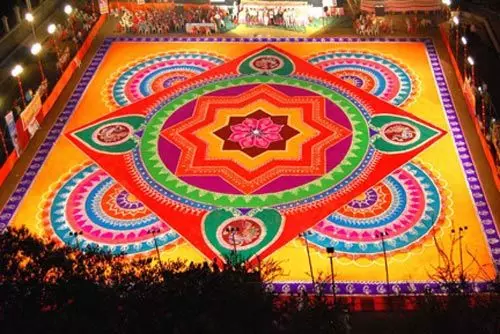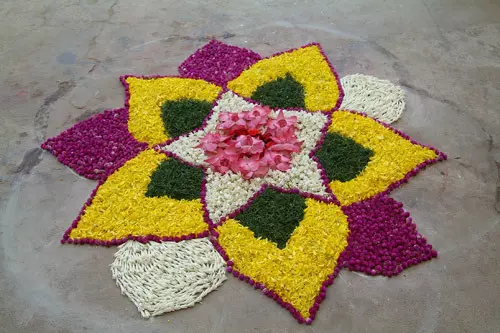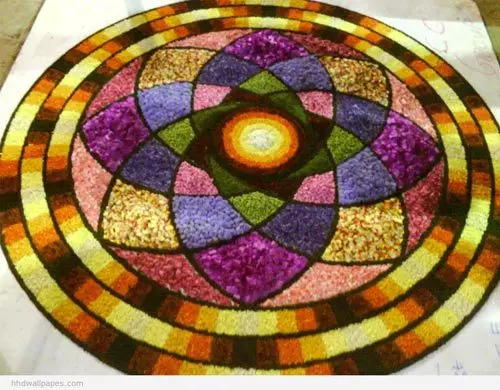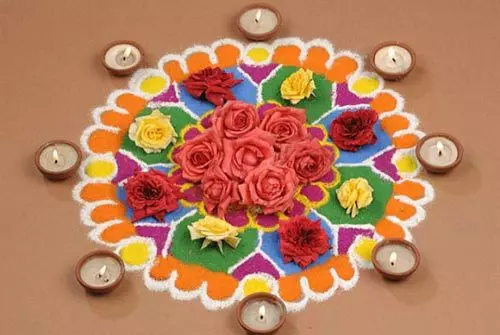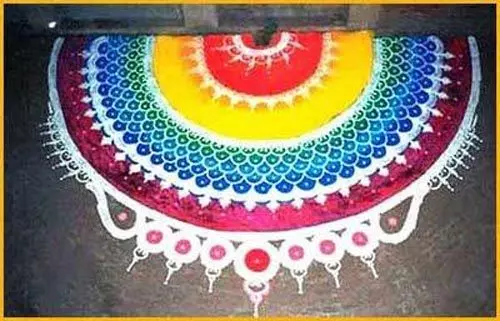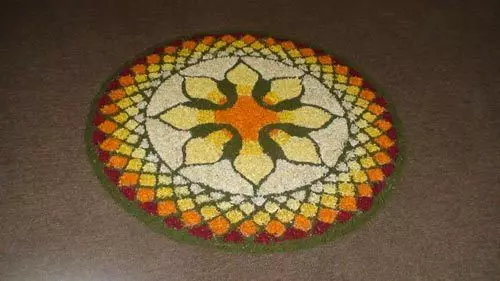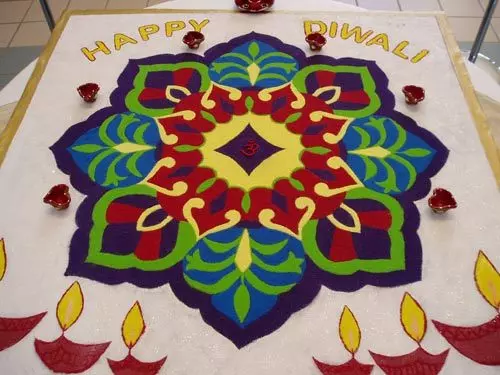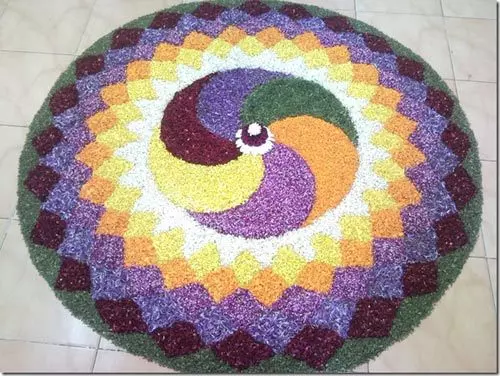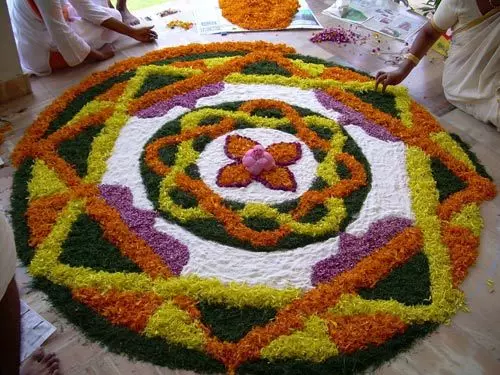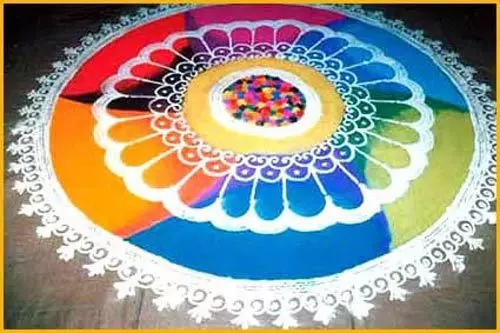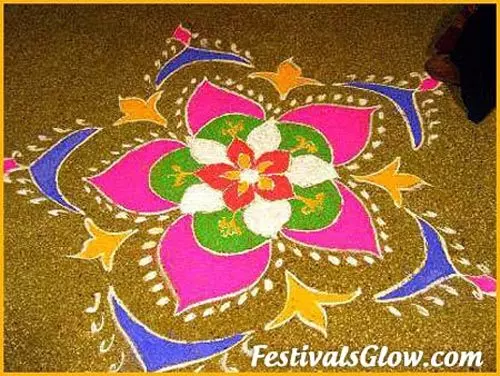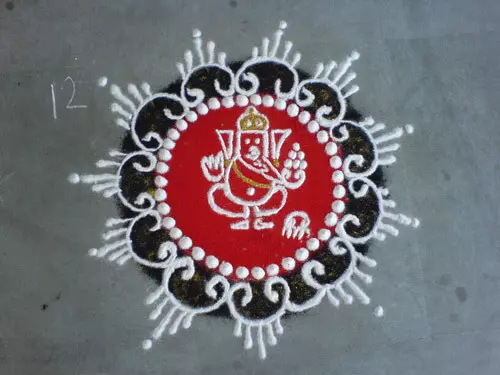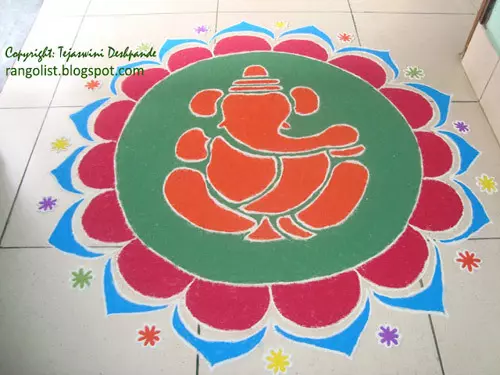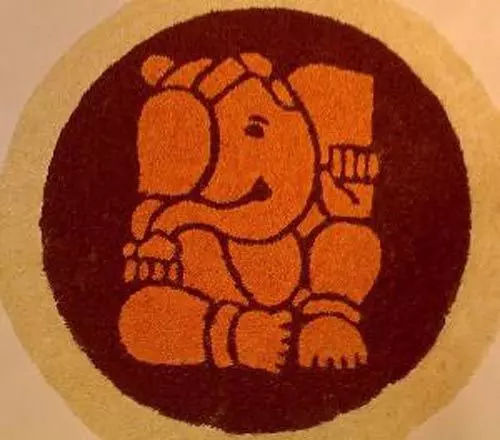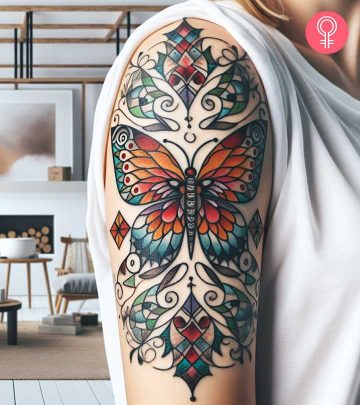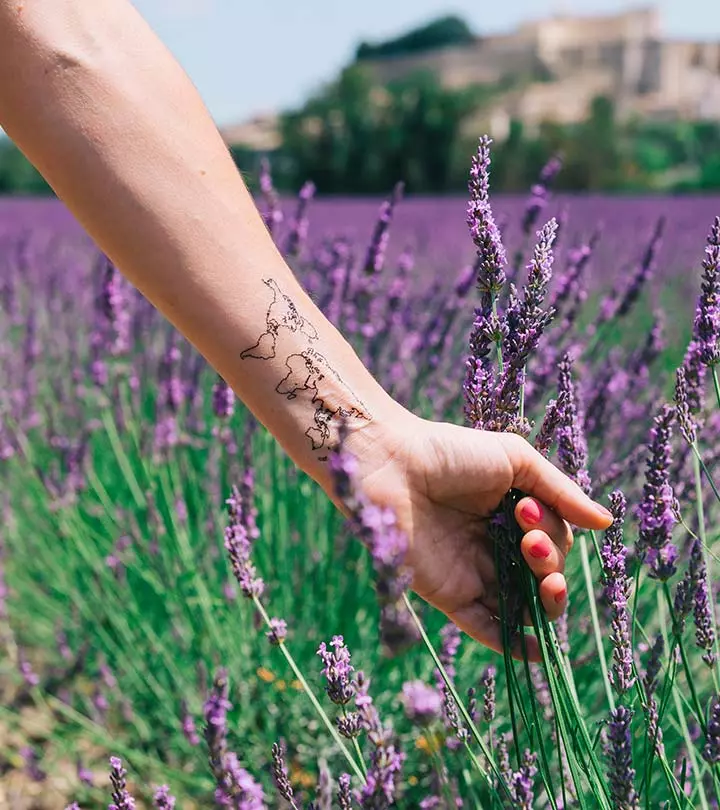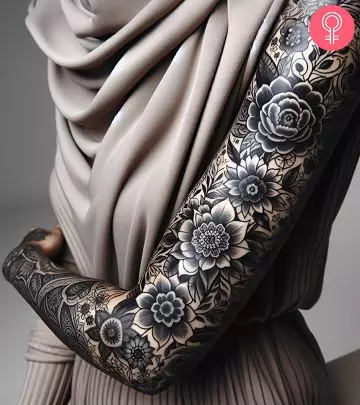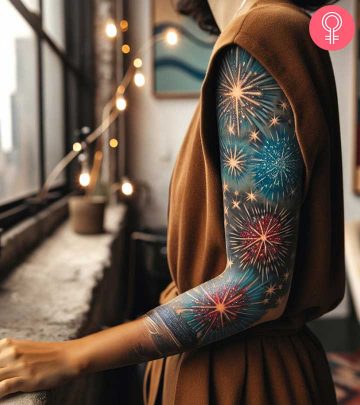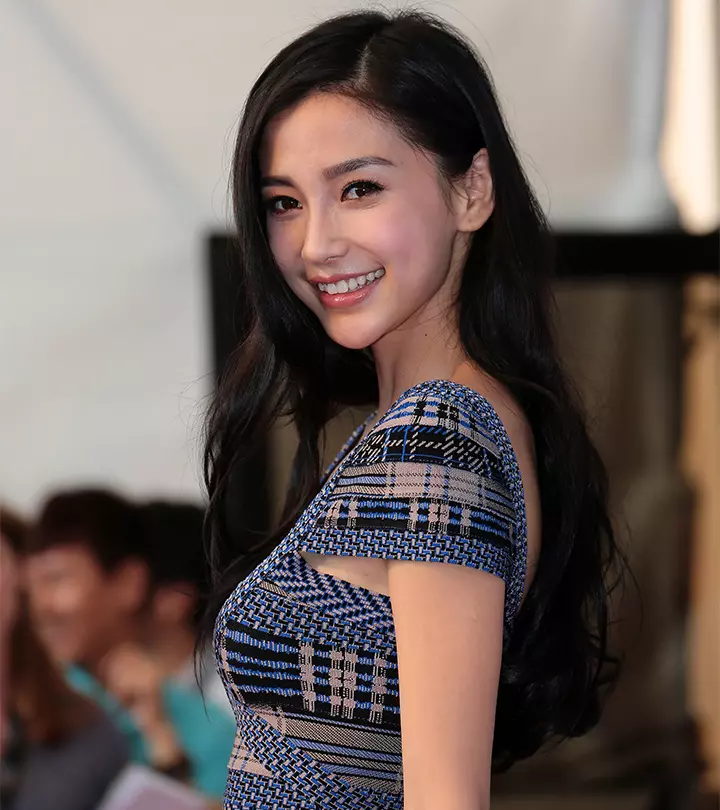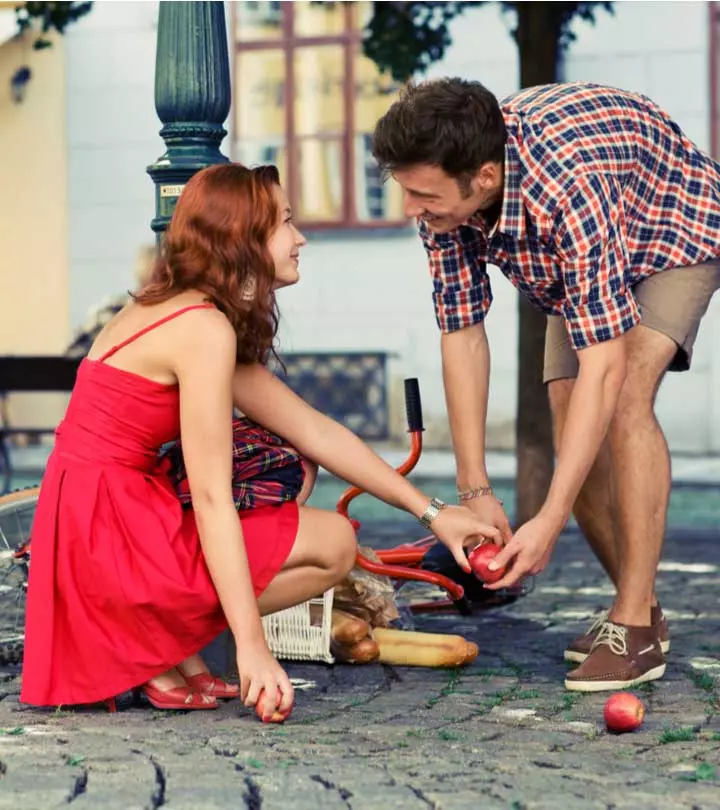50 Mesmerizing Rangoli Designs And Patterns For 2024
Get creative and go with these amazing designs to add a festive vibe to your house.

Rangoli is a creative form of art, a typical sight in many households in India. People make them on the floors, especially at the entrance of their houses, to welcome the Goddess Lakshmi – she represents fortune. In this article, we have provided you with a list of Rangoli designs and patterns worth trying.
Primarily, rice, salt, flour, flowers, leaves, vermillion, turmeric, colored sand, and unique Rangoli colors are used to make the motifs and patterns. The designs vary depending on when and where they are made. Different states of the country have different styles.
Some common ones are faces of Hindu Gods, peacock motifs, floral designs, geometric shapes, etc. These works of art can add magic to your houses. You will find them, especially during festivals. These decorations can help uplift your mood almost instantly. With some time, patience and effort, you can ace in making these designs. So, if you are a beginner or pro and looking for Rangoli inspirations, you can try the recommendations mentioned below. Scroll down to find your favorites.
In This Article
Rangoli In Different States
A wedding calls for an elaborate rangoli which occupies a large floor space. This adds the fun factor to all celebrations.India being a diverse country the designs of rangoli varies from one region to another. It’s not strange that each part of the country has its own style and way of doing Rangoli.
It also goes by different names in different states:
- Rajasthan: Mandana is a wall painting from Rajasthan done to protect the home, welcome Gods into the house and mark important festivals. These wall paintings can also be done on the floor of the house. The floor is prepared for mandana using cow dung mixed with rati or a local clay and red ochre. Then lime or chalk powder is used to create the design. The motifs are created using a brush made from date stick, cotton or tuft of hair. The designs for rangoli have peacock and floral motifs. Some even draw face of tigers and Ganesh. Mandana also reflects folk culture of Rajasthan.
- Madhya Pradesh: Chowk purna is traditional design fitted into a square with leaves and flower motifs.
- Orissa: The rangoli design in Orissa is called Ossa. Ossa designs are created to bring in health, wealth, prosperity, harmony and peace into the home. It is a way to welcome goddess Laxmi into the house. Ossa are also done to mark festivals in Orissa like Rath Yatra, Vishwakarma puja, Garbhana Sankranti, Chitalga, Apara Paksha, Basely puja, Laxmi puja and Diwali.
- West Bengal: Rangoli in West Bengal is popularly called Alpana. The intricate designs on the floor reflect the artistic skills of the people of Bengal. The 19th century Bengal Renaissance that made alpana so popular, some however traces the origins of alpana to the pre-Aryan times. The agricultural community in villages drew alpana to ward off evil spirits to ensure safety, express gratitude, to increase fertility of the cultivated land and to bring prosperity to the home. Alpana is also drawn to mark festivals or religious rituals at homes, to welcome guests and also to make the house look beautiful.
- Tamil Nadu: Rangoli designs in Tamil Nadu are called Kolam. These floral designs or Pookalam are created to celebrate the ten day Onam festival. It is believed that the soul of king Mahabali visits the city and he feels delighted to see these floral designs created in his honour at the entrances of all the houses. This is said to bring happiness, wealth and good luck to the homes. Adolescent girls love to create pookalam to welcome their favourite king Mahabali and seek his blessings. Some draw the nakshatra of the day in the pookalam to make it more auspicious, this also adds a touch of uniqueness to the kolam design. Women of the house have to create different kolam designs for the ten days of Onam. Many women gather together to make the pookalam designs, they sing traditional songs or gossip while drawing the designs.
The popular belief states that the ten rings or steps of pookalam represent the ten deities of the Hindu Pantheon. The first step represents Ganesh, the second step stands for Shiva and Shakti, the third step stands for Shiva, the fourth step defines Brahma, the fifth step for Pancha Boothangal, the sixth step represent Shanmughan or Muruga, seventh step is for Guru, the eighth step for Ashta Digpalakar, ninth step for Lord Indra and tenth step for Lord Vishnu.
Similar rangoli designs in Kerala are called Puvidal. Puv means ‘flower’ and ‘idal’ means arrangement. It is also created to mark Onam in Kerala.
- Andhra Pradesh: The entrance of the house is washed with water to clean it before drawing the muggu design. In villages the floor is prepared by applying cowdung on which the muggu is created. The dark colour of the floor creates a perfect colour contrast for the white muggu design. The Muggupindi is made out of calcium or chalk powder. Sometimes rice flour is also used. There is a technique to create a muggu design, it needs practice. Take little bit of the white powder in between the thumb and index finger and start dropping the powder from half an inch above the wet floor. The wet floor ensures the design to stay in form. This art of creating muggu is handed down from one generation to another.
- Maharashtra: As per the belief, rangvalli or Rangoli is created to repel evil spirits or negative forces from the houses. This is done to protect the inmates from any harm and bring good fortune.
- Gujarat: The rangoli designs of Gujarat is called ‘sathiya’, it is a symbolic representation of Hindu rituals and beliefs. The design comprises of dots and lines. The lines are drawn across each other and dots are put in the gaps between the lines. Mostly kumkum and rice dust is used to draw sathiya designs.
- Bihar: The rangoli design in Bihar is called aripan. It is derived from Sanskrit word alepan which means to smear. This refers to smearing the ground with clay and cow dung to purify it. Aripan originated in Mithila in Bihar, especially in the village of Madhubani. Many of the wall and floor paintings are inspired from Ramachitramanas by poet Tulsidas. Aripan is done using fingers instead of brushes. This art is to express gratitude to mother Goddess Earth. To create the aripan a paste of rice powder and water is made, this is called Pithar. To add more colours to the traditional aripans natural materials like vermillon and red clay, turmeric, leaves, soot and berries are used.
- Uttar Pradesh: The floor paintings in Uttar Pradesh are called Chowkpurana or sona rakhana. It is only done by women who sing songs related to the designs. The chowkpurana is a reflection of the folk art of state. The floor design is a daily routine and is a sign of good omen. Floor decorations are made in the altar room, around the tulsi tree in the courtyard, the dining area and of course the entrance of the house. The chowkpurana stands for religious devotion.
Interesting Legends Behind the Origin of Rangoli
The story described in Chitralakshana, the earliest treatise on Indian painting, goes like:
The king was depressed when the son of the high priest died. Lord Brahma asked the king to draw the picture of the boy on the wall so that he can bring him back to life. This was the first instance of rangoli.
The second story describes God in a creative mood. He extracted the juice of mango and created a picture of a woman on a wall, it was so beautiful that the celestial apsaras hung their heads in shame!
The rulers of the Chola Kingdom encouraged the art of rangolis. Buddhist and some Hindu literature also state that the use of sand or powder as a medium depicts impermanence of life.
Here is a list of 50 amazing Rangoli designs from across the country.
Rangoli Designs And Patterns For 2019:
- This design is apt for those who are just learning to make rangolis. The designs are kept minimum and simple so that it is easy to create. Though simple, it is colourful and can be used for Diwali, as we see in the picture. The diyas add brightness to the rangoli.
2. This rangoli design is loaded with colours which make it look so extravagant. This is definitely not for the ones who are new to this craft. Black, red, orange, blue pink and purple shades are used in this. The geometric shapes make this truly appropriate for the Diwali celebrations or for a wedding eve.
3. Now unlike usual designs of Rangoli, this one is made out of flower petals in different colours. Different coloured marigold, lotus buds and other multicoloured flower petals are used to create this beautiful design.
4. This rangoli is like a whirlwind design with different coloured flower rangoli petals. The coloursused are very striking and catch your attention easily. The interesting whirlwind makes the design look very different from the traditional rangolis that we usually come across. This one is modern and unique.
5. This design is based on the idea ‘the creator is within the creation’. This is a very elaborate design depicting a peacock with all its feathers. This design is complex and quite different.
6. Laxmi puja is celebrated in all Hindu homes. This is very colourful rangoli that can be used to welcome Goddess Laxmi into the house. The symbols related to the deity – the ‘Kalas’ and the ‘Lotus flower’ are used to make the design more appropriate for the occasion
[ Read: Indian Rangoli Designs ]
7. This rangoli is a great way to make your guests smile. It has suswagatam or welcome written that will surely make your guests feel happy. This rangoli is so colourful that you can use it to welcome the upcoming new year 2019.
8. This is a very simple design with minimum variation in colour. It can be easily done by those who are quite new to this art. You can do it for all occasions at your home.
9. A combination of contrasting and vibrant colours and the addition of diyas make it a very beautiful Rangoli. This design uses mainly geometric patterns and shapes, and can also be done by those who are just learning to make a rangoli.
10. This rangoli displays a lot of different shapes and patterns. This is a great design to decorate your home during Diwali. The little diyas in the design also makes it appropriate for the festival of lights.
11. Another Diwali rangoli design with loads of bright shades which willsurely lift your mood and make your house look all the more colourful. The bright shades like red, orange, pink, yellow, green and black are used to create this beautiful design.
[ Read: Best Pookalam Design ]
12. This design includes two peacock rangolis made on either side and in the middle there is a small tub full of floating diyas and flowers. This design is ideal for Diwali and is sure to attract attention of the guests instantly.
13. This is another rangoli that can be used for Laxmi puja and other similar religious festival at your home. Bright pink shades along with orange, white and yellow shades are used to give this rangoli a vibrant look. This one is sure to catch the attention of all your guests.
14. This rangoli design is class apart. This unique design has only a face of the deity.
15. Lord Ganesh finds a way into the art of rangoli with this awesome design. Those who are experts in rangoli can only draw this masterpiece, it is complex and someone who knows the right technique can create this design. The beautiful bluecolour makes the design even more attractive.
16. This style shows how flower petals, buds, leaves and grass can be used to make beautiful rangoli designs. These are perfect for any occasion to addcolour to your home. The main attraction of this design is the center pattern comprising of several lotus flowers.
17. The design with flower petals and diyas make it another great choice for Diwali. The gaps in this design add to its uniqueness.
18. This flower rangoli reflects the expertise and the creativity of the person who made it. The petals of the flowers are arranged with great care to make them look beautiful. This design will surely fetch you a lot of compliments.
19. This is another rangoli design you can opt for Diwali. The peacock motif looks quite nice with its vibrant tail and feathers. The use of bright colours like green, orange, yellow and blue makes this very beautiful and apt for the joyous occasion.
20. Round spiral shapes of different colours are used to make the rangoli. Different colours are used for each circle that makes the design unique. This design can be easily created by anyone.
21. This rangoli is made using different floral designs and shapes. The colours are well selected, keeping in mind the flower they represent. This design is also great choice for Diwali.
22. Another vibrant peacock design for your festive rangoli. This one is unique for its use of boldcolours which will attract attention easily. This design is also done with minute details making it a perfect choice for the festive season.
23. A beautiful floral rangoli for all of you to try at home. It’s quite easy to achieve and will brighten up the whole mood of the house. This is fit for any kind of celebration, be it wedding or a religious festival.
24. This rangoli design from Tamil Nadu, where it is called Kolam, this is suitable for festivals celebrated in the state like Onam. The contrasting colors used like green, blue and yellow makes it beautiful.
25. This Kolam or rangoli is another good option for Onam and other similar religious celebration in South of India. The bright blue and pink combo makes this a great choice. Also the geometric shapes used in the design makes it an easy choice for those who are new to this art.
26. This kolam or Rangoli shows that a person with great skills can create it. This is intricate and this is can also be used for all festivals, especially Pongal and Onam.
27. This design is a masterpiece created by expert Rangoli makers. The bright shades as well as the minute details of this rangoli make this a sure winner.
28. Another festive rangoli design for you. This one is also a very colourful one with bright pink and blue shades being used. The design also has peacock motifs.
29. The bright green shade used for this rangoli design makes this look even more beautiful. With bright shades and geometric designs, this one will surely make your guests go ‘wow’.
30. This rangoli design shows how to use flower petals to create beautiful shapes. Thediyas at each end of the design also add up to the beautiful rangoli pattern and make it apt for Diwali.
31. The use of white and bright bold colours makes this rangoli design stand out. Diyas as well as a big ‘panchpradip‘in the center makes this rangoli suitable for all festivals and formal events like inaugurations.
32. See how big this rangoli is? The design is quite simple but the plus point is its huge size. It can besurely done if you have a large open space.
33. If you thought the last one was huge, just take a look at this one. It’s humongous. Doing a Rangoli of this size takes time as well as the skill of many artists. You may try the patterns in smaller sizes at home. It can be done on any occasion.
34. This Rangoli design is suitable for Holi. Rangoli celebrates the colour that is exactly what Holi stands for. Is there any better way to celebrate Holi than doing a rangoli at home? This one is perfect for the occasion.
35. This is another rangoli design you can try on Diwali. It is very beautiful with diyas drawn on it and the ‘Om’ in the center also makes this unique and suitable for Hindu festivals.
36. This is one of the best rangoli design. This design is complex and many colours are used. This magnificent creation is done using flower petals, which adds colour and the illusion of shading.
37. A small yet beautiful rangoli design. We love how diyas and roses are used in the center to give this a nice touch.
38. This one is quite unique in respect to the design we usually see. The ‘Om’ design in the center makes it applicable for all kinds of religious celebrations. There are very minute details which also make this a very beautiful Rangoli design.
39. Now this one is a very vibrant Rangoli. With blue, yellow and orange colours being used this is surely a colorful way to decorate your home. There are fine details which makes it beautiful.
40. Here’s another floral rangoli. The very small details and the flower pattern in the center are sure to capture attention.
41. Here’s a beautiful rangoli for Diwali. The striking colours and the heart shaped diyas placed on the sides of the Rangoli make this quite different and a good choice for the occasion.
42. This rangoli design suits all occasions. The spiral pattern in the center and the use of various colours make this a very innovative Rangoli.
43. If you are all up for unique colours and designs, then this one is for you. The uniqueness of this rangoli design lies in the bright colours and the fish pattern.
44. Here’s another pretty flower Rangoli made with flower petals and leaves. The use of marigold flower is prominently seen in this design.
45. Here’s a very simple yet beautiful design to start off with in our collection. Simple geometric pattern and colours used here range from green, yellow, blue, orange and red. This bright rangoli design is a great way to introduce colours in your home; it will instantly set the mood for celebration. It’s a great choice for any festival, especially Holi.
46. This design is quite simple. It has loads of colour but the motifs or patterns are not connected. This design is great to do when there is a special occasion and you are planning to add that special touch of colour to your homes.
47. This one is specially meant for Ganpati festival and it’s quite easy to do. The basic colours used include white, black and red so that your eyes remain focused on the Ganpati design in the center.
48. Another rangoli design for the Ganpati festival! This one is a bit more colourful than the previous one and uses green, red, white, blue and orange. The main attraction here too is the Ganpati design in the middle. The striking colour combination is also a plus point in this rangoli design.
49. Another very beautiful Ganpati design using simple and earthly colours like mustard yellow, orange and brown. This is very apt for the festive season. The Ganpati design in the middle is quite tough to do, so those new to this art have to practice a little more to accomplish this design. You can leave the center design for someone who is an expert at rangolis, you can help her or observe the technique, so next time you can do it yourself.
50. Here is another design for Ganpati festival. The center of attraction here is of course lord Ganesh himself. The Ganesh rangoli design is quite unique in this and is the main theme of this Rangoli. Ganesh stands for prosperity and good luck, it can also be used for any occasion.
Images: Google
In this article, we talked about the different types of Rangolis and how different states have their distinct Rangoli designs and patterns. We have also shared some interesting legends behind the origin of this intricate and beautiful form of traditional art. Many people decorate the entrances of their homes with a different Rangoli design every day. The designs shared above are easy enough for you to try at home, even as a beginner. We hope these designs inspire you to try your hand and discover new and creative patterns of your own.
Frequently Asked Questions
Which flowers are used for Rangoli?
Rose, jasmine, marigold, crossandra, and daisy are commonly used to make Rangoli.
Can we put rangoli at night?
While in some traditions Rangoli needs to be made in the early hours of the morning, it is acceptable to make it the night before. In other traditions, Rangolis can be made at night and decorated with earthen lamps (diyas).
How many colors are there in Rangoli?
Traditionally Rangoli colors used to comprise turmeric yellow, vermillion, and other natural colors derived from petals of flowers. These days, however, artificial rangoli colors in multiple and varied shades can also be used for making the designs.



